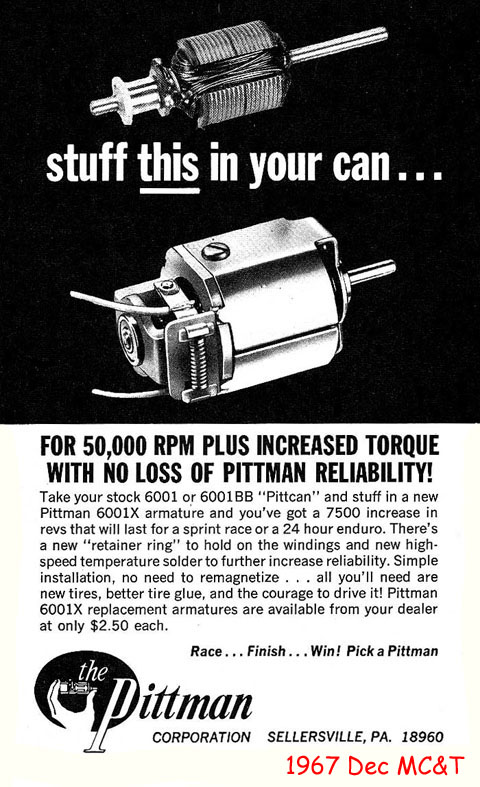Pittman DC-6001 X Armature
Photo courtesy Rick Thigpen
Early in 1966 Pittman introduced a new can motor in two variants; the DC-6001 with Oilite bushings and the DC-6001BB with good quality ball bearings. Other than the type of bearings however, these two models were identical. The DC-6001 was intended to compete with the cheap Japanese tin can motors, and looked very promising:
Auto World promptly listed the DC-6001 and DC-6001BB in their 1966-1/2 catalog:
The DC-6001 data sheet above does not indicate a voltage rating, nor does the Auto World catalog listing, but the end flap on the product box does. The DC-6001 and DC-6001BB were 6 volt motors:
The DC-6001 was faster at 12 volts than any other Pittman motor on the market at the time. Pittman was apparently no longer content to manufacture a high quality motor and leave it at that, this was a whole new motor specifically designed to compete at the top level; they were now dabbling in the hard-core pro racing game. Pittman even sponsored a racing team for awhile.
The DC-6001 enjoyed some success, but evidently not enough in the pro ranks. Hard-core rabid pro-racers wanted ever more RPM, horsepower and brakes from their motors, and fast as it was, the DC-6001 found itself having a hard time keeping up with the rapidly evolving Japanese tin cans.
So in late 1966, as they had done with the DC-65A-6 and DC-85A-6, Pittman once again created an "X" variant, only this time it was not a DC-6001X motor; it was an X variant armature.
Auto World again promptly listed it in their (now 1967) catalog as a "6001 Pittman High Performance Armature":
Pittman went so far as to advertise their new armature in the March 1967 issue of Car Model and later in the December issue of Model Car & Track, claiming 50,000 RPM; a 7,500 RPM increase over the "stock" 6001 armatures:
Pittman never rated the 6001X armature in terms of voltage, but to be fair, the practice of rating motors and armatures by voltage was by 1967 falling out of favor anyway.
50,000 RPM is a rather impressive speed for an unbalanced motor. Keeping in mind that the "stock" DC-6001 was a 6 volt motor, and that Pittman stated their 6001X armature was nothing less than 42% faster than the "stock" motor, it seems reasonably obvious that the 6001X armature had to be something "hotter" than a 6 volts.























